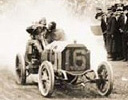Machine Beauty
IRL vs. CART Car Aesthetics
"When I am working on a problem, I never think about beauty, but when I have finished, if the
solution is not beautiful, I know it is wrong."
- R Buckminster Fuller
Twenty years of survival of the fittest has created a lithe, supple, missile of a chassis for the CART FedEx
Championship series. What does the IRL have to show for it's first five years? A rules mandated Frankenstein of
carbon fiber and Kevlar.
When Tony George rallied the faithful in 1994 and declared his jihad against CART and all things effete and
foreign, the media and fans alike scrutinized the strengths and weaknesses of both CART and George's Indy Racing
League ad nauseam.
Engine leases vs. outright ownership, oval tracks vs. road courses, American drivers vs.
foreign drivers, high tech vs. low tech, have all been discussed and dissected. Yet one by-product of this war
has rarely been mentioned – the downright homely appearance of the IRL cars.
The IRL machines just don't look right to me. They haven't from day one. They offend my natural sense of
proportion, a sense all of us have. It's this innate sense that makes us melt at the
sight of a baby's round little face and chubby cheeks. It's this sense that made us perk up and take notice the
first time we laid eyes on our future significant other. Call it a sense of beauty or aesthetics, whatever it
is, this preference for appealing shapes and contours is inherent in our brains and is one of the often overlooked
reasons why auto racing appeals to so many. Racecars can be stunningly beautiful.
Yet, in a classic case of putting the cart before the horse, the IRL’s faux populist manifesto, written long
before the first Dallara or G-Force had turned a wheel, ended up creating some horribly misshapen machinery.
The bulbous engine cowling is the main culprit here. Perched behind the driver's head like some hollow faced
gargoyle, this appendage dominates the IRL chassis' skyline. The slavish insistence by the IRL that engine
dimensions resemble those that roll off the assembly lines in Detroit and the rather odd belief that normally
aspirated engines are by definition cheaper to build both conspired to make the rudder like cowling a necessity.
The width of the engine determines the minimum width of the "fuselage" of a single seat chassis. From the nose
through the cockpit section to the engine compartment, the IRL cars are perceptibly wider than their CART
counterparts. This girth through the middle makes the visual mass of the car appear much too portly for an object
that we associate with "flying on the ground." The tall, wide side pods, especially those on the G-Force, which
rise in an arc from the radiator inlet to the rear wheel like the wings of a manta ray, end up amplifying the
pudge through the waistline on the IRL cars.
The rear wing endplates are much larger than those of CART, required no doubt to keep what little air that
manages to slip around the cowling from bleeding off the wing chord. This adds more visual bulk at the rear.
Also, the back shattering transmission housing hangs down well behind the centerline of the rear wheels, whereas
the transverse CART gearbox is nearly invisible, tucked up neatly behind the engine.
Comparing the G-Force or Dallara to a Reynard or Lola, you intuitively sense that the mass of the Champ car is
focused about its center, just as it should be. More importantly, from a visual standpoint, a Reynard or Lola
fits our psychological prejudices much better than a G-Force or Dallara.
Aerodynamics is the defining force in modern Indy car design, and a Reynard looks better prepared to utilize
the air than does a Dallara. Look at a Reynard and you're likely to think of an F-15 or maybe an F-22. Look at
a G-Force and what comes to mind? Maybe
a KC135?
Even the Luddites that run NASCAR have a leg up on the IRL in terms of racecar aesthetics. They have the
wonderful advantage of being able to reverse engineer all the design work that the studios at Ford, GM and
Chrysler have collectively put into their road cars. A Taurus may not be a sleek bullet, but it is familiar, and
obviously thousands if not millions of Americans like its bulbous windows and pinched nose and tail. By racing
models that are obsolete every few years, NASCAR by default keeps its cars fresh and up to date with the buying
public's tastes. Think of how boxy and antiquated the mid-90's Lumina now seems compared to the 2001 Monte Carlo.
Does this imply that racecar designers should take steps to make their machines more visually appealing merely
for the sake of beauty? If the sanctioning body allows for as much innovation as is sensible within a stable
rules environment, the evolution of design should naturally create an eye appealing machine, as Buckminster
Fuller's quote above alludes to.
Both CART and NASCAR have been more progressive than the IRL in allowing
technical development to proceed at a reasonable pace and fans sense the subtle differences that this approach
creates in each year's cars. Let's face it, the IRL is in everything but name a spec series. It is also a young
series with only two chassis builders and essentially one engine provider. Even if it were not clearly against
the rules in most cases to do so, there is simply no impetus for technological advancement since there is little
or no competition between the manufacturers, which is a stark contrast to the knife fight environment that exists
among the manufacturers in the CART paddock.
Some would argue that this highly constricted approach to chassis development was the whole idea behind the
genesis of the IRL, to keep costs down. Unfortunately, fans of the Indy 500 and American open wheeled racing have
come to expect a certain amount of technological development and evolution, especially among today's tech savvy
youth.
Both CART and NASCAR have a number of years under their respective belts and in that time both have seen
their share of advancement which, each in their own way, has given them a sense of progress, of keeping up with
the times, both aesthetically and technically.
Any engineer will tell you that there is no such thing as a perfect
design. Compromises are a part of the process yet the IRL, by rigidly dictating chassis and engine dimensions,
has forced its chassis builders to produce cars that are aesthetically awkward at best. This might be acceptable,
in the name of cost containment, if the IRL were a development or feeder series, but these are, for better or
worse, the cars that run on the most famous track in the world in the most famous race in the world. For that
reason alone, they should be the most technically and aesthetically advanced cars in the world.
Copyright © 2001 by Tim Layman and Deep Throttle. All Rights Reserved.
| 



